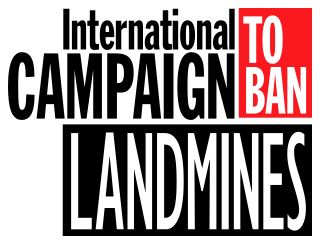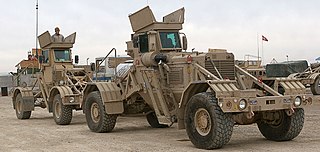
A land mine is an explosive device concealed under or on the ground and designed to destroy or disable enemy targets, ranging from combatants to vehicles and tanks, as they pass over or near it. Such a device is typically detonated automatically by way of pressure when a target steps on it or drives over it, although other detonation mechanisms are also sometimes used. A land mine may cause damage by direct blast effect, by fragments that are thrown by the blast, or by both.

The International Campaign to Ban Landmines (ICBL) is a coalition of non-governmental organizations whose stated objective is a world free of anti-personnel mines and cluster munitions, where mine and cluster munitions survivors see their rights respected and can lead fulfilling lives.

The HALO Trust is a non-political and non-religious registered British charity and American non-profit organization which removes debris left behind by war, in particular land mines. With over 8,000 deminers worldwide, HALO has operations in 28 countries. Its largest operation is in Afghanistan, where the organization continues to operate under the Taliban regime that took power in August 2021.

An anti-tank mine is a type of land mine designed to damage or destroy vehicles including tanks and armored fighting vehicles.

Demining or mine clearance is the process of removing land mines from an area. In military operations, the object is to rapidly clear a path through a minefield, and this is often done with devices such as mine plows and blast waves. By contrast, the goal of humanitarian demining is to remove all of the landmines to a given depth and make the land safe for human use. Specially trained dogs are also used to narrow down the search and verify that an area is cleared. Mechanical devices such as flails and excavators are sometimes used to clear mines.

A mine flail is a vehicle-mounted device that makes a safe path through a minefield by deliberately detonating land mines in front of the vehicle that carries it. They were first used by the British during World War II.
A mine clearance organization, or demining organization, is an organization involved in removal of landmines and unexploded ordnance (UXO) for military, humanitarian, or commercial reasons. Demining includes mine clearance, as well as surveying, mapping and marking of hazardous areas.
The Geneva International Centre for Humanitarian Demining is an international organisation working in mine action. Based in the Maison de la paix in Geneva, it is legally a non-profit foundation in Switzerland.

The region of Nagorno-Karabakh and areas around it are considered to be some of the most heavily mined regions of the former Soviet Union. Mines were laid from early 1990s by both Azerbaijani and Armenian forces during and after the First Nagorno-Karabakh War. The worst-affected areas are along the fortified former contact line between Azerbaijani and Armenian forces, in particular in the districts of Agdam, Fuzuli and Jabrayil. According to military experts from both Azerbaijan and Armenia, the ground in those areas is covered with "carpets of land mines."
Mine action is a combination of humanitarian aid and development studies that aims to remove landmines and reduce the social, economic and environmental impact of them and the explosive remnants of war (ERW).

The Husky VMMD is a South African configurable counter-IED MRAP designed for route clearance and demining. It is designed to assist in the disposal of land mines and improvised explosive devices.

The Mines Advisory Group (MAG) is a non-governmental organization that assists people affected by landmines, unexploded ordnance, and small arms and light weapons.

The United Nations Mine Action Service (UNMAS) is a service located within the United Nations Department of Peacekeeping Operations that specializes in coordinating and implementing activities to limit the threat posed by mines, explosive remnants of war and improvised explosive devices.
Since the outbreak of the First Indochina War in 1946 and later the bloodier Second Indochina War of the 1960s and 1970s, countless numbers of land mines have been planted in what is now the Socialist Republic of Vietnam. Many of these devices that did not detonate at some point or another remain a very dangerous menace that continues plaguing the country and surrounding areas.
Golden West Humanitarian Foundation is an American Non-profit (501C3) organisation that develops technologies to address the technical limitations of humanitarian mine clearance. The Golden West Humanitarian Foundation is based in Woodland Hills, Los Angeles, California.

Unmanned systems of the British Army is a list of all modern and in service remote and unmanned surveillance, reconnaissance, bomb disposal and combat systems of the British Army.
Gender mainstreaming in mine action is the application of gender mainstreaming to mine action. It is increasingly being adopted by international and state mine action organizations.

Approximately 30,000 land mines were laid in the British overseas territory of the Falkland Islands by Argentinian forces following their 1982 invasion. Some of the mines were cleared immediately following the successful British operation to retake the islands but following a series of accidents demining operations ceased. In the following years the mine fields were fenced off and, with human access limited, became havens for Falklands flora and the native penguin population. The British government ratified the Ottawa Treaty in 1998 that required the removal of all mines within its territory. Demining operations, which had to be carried out by hand due to the climate and local condition, restarted in 2009. The last mines were cleared in October 2020.

Azerbaijan National Agency for Mine Action (ANAMA) is a mine action agency and executive body under State Commission for Reconstruction and Rehabilitation of War-Affected Areas of the Republic of Azerbaijan. The agency is accountable for implementing all necessary procedures corresponding to Azerbaijan Mine Action Program in order to decontaminate mines within the territory of Azerbaijan. Donors of the agency are government of Azerbaijan and UNDP ($160,000).

ITF Enhancing Human Security is a humanitarian, non-profit organization founded by the Republic of Slovenia., which specializes in land mine clearance and post-conflict reconstruction. It was established on 12 March 1998 with the purpose of helping Bosnia and Herzegovina in its post-conflict rehabilitation, specifically with mine clearance and assistance to mine victims.













